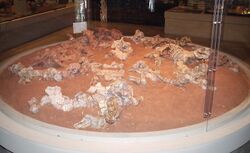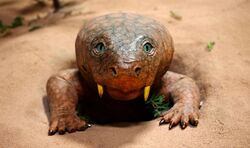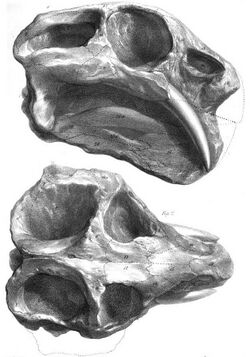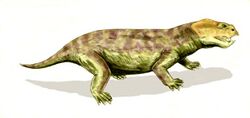Biology:Dicynodont
| Dicynodonts | |
|---|---|
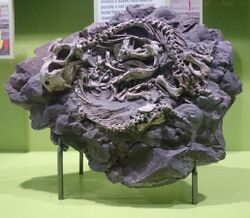
| |
| Skeleton of Diictodon | |
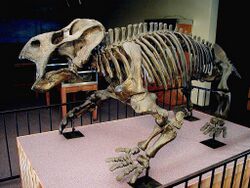
| |
| Skeleton of Placerias | |
| Scientific classification | |
| Domain: | Eukaryota |
| Kingdom: | Animalia |
| Phylum: | Chordata |
| Clade: | Synapsida |
| Clade: | Therapsida |
| Suborder: | †Anomodontia |
| Clade: | †Chainosauria |
| Clade: | †Dicynodontia Owen, 1859 |
| Clades & genera | |
|
see "Taxonomy" | |
Dicynodontia is an extinct clade of anomodonts, an extinct type of non-mammalian therapsid. Dicynodonts were herbivores that typically bore a pair of tusks, hence their name, which means 'two dog tooth'. Members of the group possessed a horny, typically toothless beak, unique amongst all synapsids. Dicynodonts first appeared in Southern Pangaea during the mid-Permian, ca. 270–260 million years ago, and became globally distributed and the dominant herbivorous animals in the Late Permian, ca. 260–252 Mya. They were devastated by the end-Permian Extinction that wiped out most other therapsids ca. 252 Mya. They rebounded during the Triassic but died out towards the end of that period. They were the most successful and diverse of the non-mammalian therapsids, with over 70 genera known, varying from rat-sized burrowers to elephant-sized browsers.
Characteristics
The dicynodont skull is highly specialised, light but strong, with the synapsid temporal openings at the rear of the skull greatly enlarged to accommodate larger jaw muscles. The front of the skull and the lower jaw are generally narrow and, in all but a number of primitive forms, toothless. Instead, the front of the mouth is equipped with a horny beak, as in turtles and ceratopsian dinosaurs. Food was processed by the retraction of the lower jaw when the mouth closed, producing a powerful shearing action,[2] which would have enabled dicynodonts to cope with tough plant material. Dicynodonts typically had a pair of enlarged maxillary caniniform teeth, analogous to the tusks present in some living mammals. In the earliest genera, they were merely enlarged teeth, but in later forms they independently evolved into ever-growing teeth like mammal tusks multiple times.[3] In some dicynodonts, the presence of tusks has been suggested to be sexually dimorphic.[4] Some dicynodonts such as Stahleckeria lacked true tusks and instead bore tusk-like extensions on the side of the beak.[5][6]:139
The body is short, strong and barrel-shaped, with strong limbs. In large genera (such as Dinodontosaurus) the hindlimbs were held erect, but the forelimbs bent at the elbow. Both the pectoral girdle and the ilium are large and strong. The tail is short.[citation needed]
Endothermy and soft tissue anatomy
Dicynodonts have long been suspected of being warm-blooded animals. Their bones are highly vascularised and possess Haversian canals, and their bodily proportions are conducive to heat preservation.[7] In young specimens, the bones are so highly vascularised that they exhibit higher channel densities than most other therapsids.[8] Yet, studies on Late Triassic dicynodont coprolites paradoxically showcase digestive patterns more typical of animals with slow metabolisms.[9]
More recently, the discovery of hair remnants in Permian coprolites possibly vindicates the status of dicynodonts as endothermic animals. As these coprolites come from carnivorous species and digested dicynodont bones are abundant, it has been suggested that at least some of these hair remnants come from dicynodont prey.[10] A new study using chemical analysis seemed to suggest that cynodonts and dicynodonts both developed warm blood independently before the Permian extinction.[11] Pentasauropus dicynodont tracks suggest that dicynodonts had fleshy pads on their feet.[12] Mummified skin from specimens of Lystrosaurus in South Africa have numerous raised bumps.[13]
History
Dicynodonts have been known since the mid-1800s. The South African geologist Andrew Geddes Bain gave the first description of dicynodonts in 1845. At the time, Bain was a supervisor for the construction of military roads under the Corps of Royal Engineers and had found many reptilian fossils during his surveys of South Africa. Bain described these fossils in an 1845 letter published in Transactions of the Geological Society of London, calling them "bidentals" for their two prominent tusks.[14] In that same year, the English paleontologist Richard Owen named two species of dicynodonts from South Africa: Dicynodon lacerticeps and Dicynodon bainii. Since Bain was preoccupied with the Corps of Royal Engineers, he wanted Owen to describe his fossils more extensively. Owen did not publish a description until 1876 in his Descriptive and Illustrated Catalogue of the Fossil Reptilia of South Africa in the Collection of the British Museum.[15] By this time, many more dicynodonts had been described. In 1859, another important species called Ptychognathus declivis was named from South Africa. In the same year, Owen named the group Dicynodontia.[16] In his Descriptive and Illustrated Catalogue, Owen honored Bain by erecting Bidentalia as a replacement name for his Dicynodontia.[15] The name Bidentalia quickly fell out of use in the following years, replaced by popularity of Owen's Dicynodontia.[17]
Evolutionary history
Dicynodonts first appeared during the Middle Permian in the Southern Hemisphere, with South Africa being the centre of their known diversity, and underwent a rapid evolutionary radiation, becoming globally distributed and amongst the most successful and abundant land vertebrates during the Late Permian.[18][19] During this time, they included a large variety of ecotypes, including large, medium-sized, and small herbivores and short-limbed mole-like burrowers.[20]
Only four lineages are known to have survived the Great Dying; the first three represented with a single genus each: Myosaurus, Kombuisia, and Lystrosaurus, the latter being the most common and widespread herbivores of the Induan (earliest Triassic). None of these survived long into the Triassic. The fourth group was the Kannemeyeriiformes, the only dicynodonts who diversified during the Triassic.[21] These stocky, pig- to ox-sized animals were the most abundant herbivores worldwide from the Olenekian to the Ladinian age. By the Carnian they had been supplanted by traversodont cynodonts and rhynchosaur reptiles. During the Norian (middle of the Late Triassic), perhaps due to increasing aridity, they drastically declined, and the role of large herbivores was taken over by sauropodomorph dinosaurs.[citation needed]
Fossils of an Asian elephant-sized dicynodont Lisowicia bojani discovered in Poland indicate that dicynodonts survived at least until the late Norian or earliest Rhaetian (latest Triassic); this animal was also the largest known dicynodont species.[22][23]
Six fragments of fossil bone discovered in Queensland, Australia, were interpreted as remains of a skull in 2003. This suggested to indicate that dicynodonts survived into the Cretaceous in southern Gondwana.[24] The dicynodont affinity of these specimens was questioned (including a proposal that they belonged to a baurusuchian crocodyliform by Agnolin et al. in 2010),[25] and in 2019 Knutsen and Oerlemans considered this fossil to be of Plio-Pleistocene age, and reinterpreted it as a fossil of a large mammal, probably a diprotodontid.[26]
With the decline and extinction of the kannemeyerids, there were to be no more dominant large synapsid herbivores until the middle Paleocene epoch (60 Ma) when mammals, distant descendants of cynodonts, began to diversify after the extinction of the non-avian dinosaurs.
Systematics
Taxonomy
Dicynodontia was originally named by the English paleontologist Richard Owen. It was erected as a family of the order Anomodontia and included the genera Dicynodon and Ptychognathus. Other groups of Anomodontia included Gnathodontia, which included Rhynchosaurus (now known to be an archosauromorph) and Cryptodontia, which included Oudenodon. Cryptodonts were distinguished from dicynodonts from their absence of tusks. Although it lacks tusks, Oudenodon is now classified as a dicynodont, and the name Cryptodontia is no longer used. Thomas Henry Huxley revised Owen's Dicynodontia as an order that included Dicynodon and Oudenodon.[27] Dicynodontia was later ranked as a suborder or infraorder with the larger group Anomodontia, which is classified as an order. The ranking of Dicynodontia has varied in recent studies, with Ivakhnenko (2008) considering it a suborder, Ivanchnenko (2008) considering it an infraorder, and Kurkin (2010) considering it an order.[28]
Many higher taxa, including infraorders and families, have been erected as a means of classifying the large number of dicynodont species. Cluver and King (1983) recognised several main groups within Dicynodontia, including Eodicynodontia (containing only Eodicynodon), Endothiodontia (containing only Endothiodontidae), Pristerodontia (Pristerodontidae, Cryptodontidae, Aulacephalodontidae, Dicynodontidae, Lystrosauridae, and Kannemeyeriidae), Kingoriamorpha (containing only Kingoriidae), Diictodontia (Diictodontidae, Robertiidae, Cistecephalidae, Emydopidae and Myosauridae), and Venyukoviamorpha.[29] Most of these taxa are no longer considered valid. Kammerer and Angielczyk (2009) suggested that the problematic taxonomy and nomenclature of Dicynodontia and other groups results from the large number of conflicting studies and the tendency for invalid names to be mistakenly established.[17]

150px|thumb|Placerias
Current classification
- Dicynodontia
- Brachyprosopus
- Colobodectes
- Eodicynodon
- Lanthanostegus
- Endothiodontia
- Abajudon
- Endothiodon
- Niassodon
- Eumantellidae
- Therochelonia
Phylogeny
Below is a cladogram modified from Angielczyk et al. (2021):[30]
| Dicynodontia |
| ||||||||||||||||||||||||||||||||||||||||||||||||
See also
References
- ↑ Racki, Grzegorz; Lucas, Spencer G. (2018). "Timing of dicynodont extinction in light of an unusual Late Triassic Polish fauna and Cuvier's approach to extinction". Historical Biology 32 (4): 1–11. doi:10.1080/08912963.2018.1499734.
- ↑ Crompton, A. W.; Hotton, N. (1967). "Functional morphology of the masticatory apparatus of two dicynodonts (Reptilia, Therapsida)". Postilla 109: 1–51.
- ↑ Whitney, M. R.; Angielczyk, K. D.; Peecook, B. R.; Sidor, C. A. (2021). "The evolution of the synapsid tusk: Insights from dicynodont therapsid tusk histology". Proceedings of the Royal Society B: Biological Sciences 288 (1961). doi:10.1098/rspb.2021.1670. PMID 34702071.
- ↑ Angielczyk, Kenneth D.; Benoit, Julien; Rubidge, Bruce S. (February 2021). Ruta, Marcello. ed. "A new tusked cistecephalid dicynodont (Therapsida, Anomodontia) from the upper Permian upper Madumabisa Mudstone Formation, Luangwa Basin, Zambia" (in en). Papers in Palaeontology 7 (1): 405–446. doi:10.1002/spp2.1285. ISSN 2056-2799. https://onlinelibrary.wiley.com/doi/10.1002/spp2.1285.
- ↑ Kammerer, Christian F.; Ordoñez, Maria de los Angeles (2021-06-01). "Dicynodonts (Therapsida: Anomodontia) of South America" (in en). Journal of South American Earth Sciences 108: 103171. doi:10.1016/j.jsames.2021.103171. ISSN 0895-9811. Bibcode: 2021JSAES.10803171K. https://www.sciencedirect.com/science/article/pii/S0895981121000183.
- ↑ Colbert, E. H., (1969), Evolution of the Vertebrates, John Wiley & Sons Inc (2nd ed.)
- ↑ Bakker, Robert T. (April 1975). "Dinosaur renaissance". Scientific American 232 (4): 58–79. doi:10.1038/scientificamerican0475-58. Bibcode: 1975SciAm.232d..58B.
- ↑ Botha-Brink, Jennifer; Angielczyk, Kenneth D. (2010). "Do extraordinarily high growth rates in Permo-Triassic dicynodonts (Therapsida, Anomodontia) explain their success before and after the end-Permian extinction?". Zoological Journal of the Linnean Society 160 (2): 341–365. doi:10.1111/j.1096-3642.2009.00601.x.
- ↑ Bajdek, Piotr; Owocki, Krzysztof; Niedźwiedzki, Grzegorz (2014). "Putative dicynodont coprolites from the Upper Triassic of Poland". Palaeogeography, Palaeoclimatology, Palaeoecology 411: 1–17. doi:10.1016/j.palaeo.2014.06.013. Bibcode: 2014PPP...411....1B.
- ↑ Bajdek, Piotr; Qvarnström, Martin; Owocki, Krzysztof; Sulej, Tomasz; Sennikov, Andrey G.; Golubev, Valeriy K.; Niedźwiedzki, Grzegorz (2016). "Microbiota and food residues including possible evidence of pre-mammalian hair in Upper Permian coprolites from Russia". Lethaia 49 (4): 455–477. doi:10.1111/let.12156.
- ↑ Rey, Kévin; Amiot, Romain; Fourel, François; Abdala, Fernando; Fluteau, Frédéric; Jalil, Nour-Eddine; Liu, Jun; Rubidge, Bruce S. et al. (2017). "Oxygen isotopes suggest elevated thermometabolism within multiple Permo-Triassic therapsid clades". eLife 6: e28589. doi:10.7554/eLife.28589. PMID 28716184.
- ↑ Citton, Paolo; Díaz-Martínez, Ignacio; de Valais, Silvina; Cónsole-Gonella, Carlos (7 August 2018). "Triassic pentadactyl tracks from the Los Menucos Group (Río Negro province, Patagonia Argentina): possible constraints on the autopodial posture of Gondwanan trackmakers". PeerJ 6: e5358. doi:10.7717/peerj.5358. PMID 30123702.
- ↑ Smith, Roger M.H.; Botha, Jennifer; Viglietti, Pia A. (October 2022). "Taphonomy of drought afflicted tetrapods in the Early Triassic Karoo Basin, South Africa" (in en). Palaeogeography, Palaeoclimatology, Palaeoecology 604: 111207. doi:10.1016/j.palaeo.2022.111207. Bibcode: 2022PPP...60411207S. https://linkinghub.elsevier.com/retrieve/pii/S0031018222003777.
- ↑ Bain, A.G. (1845). "On the discovery of fossil remains of bidental and other reptiles in South Africa". Transactions of the Geological Society of London 1: 53–59. doi:10.1144/GSL.JGS.1845.001.01.72. https://zenodo.org/record/1673362.
- ↑ 15.0 15.1 Owen, R. (1876). Descriptive and Illustrated Catalogue of the Fossil Reptilia of South Africa in the Collection of the British Museum. London: British Museum. p. 88.
- ↑ Owen, R. (1860). "On the orders of fossil and recent Reptilia, and their distribution in time". Report of the Twenty-Ninth Meeting of the British Association for the Advancement of Science 1859: 153–166.
- ↑ 17.0 17.1 Kammerer, C.F.; Angielczyk, K.D. (2009). "A proposed higher taxonomy of anomodont therapsids". Zootaxa 2018: 1–24. http://www.mapress.com/zootaxa/2009/f/z02018p024f.pdf.
- ↑ Kurkin, A. A. (July 2011). "Permian anomodonts: Paleobiogeography and distribution of the group" (in en). Paleontological Journal 45 (4): 432–444. doi:10.1134/S0031030111030075. ISSN 0031-0301. http://link.springer.com/10.1134/S0031030111030075.
- ↑ Olroyd, Savannah L.; Sidor, Christian A. (August 2017). "A review of the Guadalupian (middle Permian) global tetrapod fossil record". Earth-Science Reviews 171: 583–597. doi:10.1016/j.earscirev.2017.07.001. ISSN 0012-8252. Bibcode: 2017ESRv..171..583O.
- ↑ Angielczyk, Kenneth D.; Kammerer, Christian F. (2018). "5. Non-Mammalian synapsids: The deep roots of the mammalian family tree". Mammalian Evolution, Diversity and Systematics. pp. 117–198. doi:10.1515/9783110341553-005. ISBN 9783110341553.
- ↑ Kammerer, Christian F.; Fröbisch, Jörg; Angielczyk, Kenneth D. (31 May 2013). "On the validity and phylogenetic position of Eubrachiosaurus browni, a kannemeyeriiform dicynodont (Anomodontia) from Triassic North America". PLOS ONE 8 (5): e64203. doi:10.1371/journal.pone.0064203. PMID 23741307. Bibcode: 2013PLoSO...864203K.
- ↑ Tomasz Sulej; Grzegorz Niedźwiedzki (2019). "An elephant-sized Late Triassic synapsid with erect limbs". Science 363 (6422): 78–80. doi:10.1126/science.aal4853. PMID 30467179. Bibcode: 2019Sci...363...78S.
- ↑ St. Fleur, Nicholas (4 January 2019). "An Elephant-Size Relative of Mammals That Grazed Alongside Dinosaurs". The New York Times. https://www.nytimes.com/2019/01/04/science/dicynodonts-fossils-poland.html.
- ↑ Thulborn, T.; Turner, S. (2003). "The last dicynodont: an Australian Cretaceous relict". Proceedings of the Royal Society B: Biological Sciences 270 (1518): 985–993. doi:10.1098/rspb.2002.2296. PMID 12803915.
- ↑ Agnolin, F. L.; Ezcurra, M. D.; Pais, D. F.; Salisbury, S. W. (2010). "A reappraisal of the Cretaceous non-avian dinosaur faunas from Australia and New Zealand: Evidence for their Gondwanan affinities". Journal of Systematic Palaeontology 8 (2): 257–300. doi:10.1080/14772011003594870. https://espace.library.uq.edu.au/view/UQ:206067/UQ206067.pdf.
- ↑ Espen M. Knutsen; Emma Oerlemans (2019). "The last dicynodont? Re-assessing the taxonomic and temporal relationships of a contentious Australian fossil". Gondwana Research 77: 184–203. doi:10.1016/j.gr.2019.07.011.
- ↑ Osborn, H.F. (1904). "Reclassification of the Reptilia". The American Naturalist 38 (446): 93–115. doi:10.1086/278383. https://books.google.com/books?id=EHMWAAAAYAAJ.
- ↑ Kurkin, A.A. (2010). "Late Permian dicynodonts of Eastern Europe". Paleontological Journal 44 (6): 72–80. doi:10.1134/S0031030110060092.
- ↑ Cluver, M.A.; King, G.M. (1983). "A reassessment of the relationships of Permian Dicynodontia (Reptilia, Therapsida) and a new classification of dicynodont". Annals of the South African Museum 91: 195–273.
- ↑ Angielczyk, K. D.; Liu, J.; Yang, W. (2021). "A Redescription of Kunpania scopulusa, a Bidentalian Dicynodont (Therapsida, Anomodontia) from the ?Guadalupian of Northwestern China". Journal of Vertebrate Paleontology 41 (1): e1922428. doi:10.1080/02724634.2021.1922428. Bibcode: 2021JVPal..41E2428A.
Further reading
- Carroll, R. L. (1988), Vertebrate Paleontology and Evolution, WH Freeman & Co.
- Cox, B., Savage, R.J.G., Gardiner, B., Harrison, C. and Palmer, D. (1988) The Marshall illustrated encyclopedia of dinosaurs & prehistoric animals, 2nd Edition, Marshall Publishing
- King, Gillian M., "Anomodontia" Part 17 C, Encyclopedia of Paleoherpetology, Gutsav Fischer Verlag, Stuttgart and New York, 1988
- King, Gillian M., 1990, The Dicynodonts: A Study in Palaeobiology, Chapman and Hall, London and New York
External links
Wikidata ☰ Q131682 entry
 |
